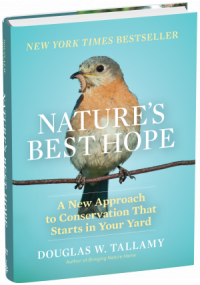About the Book
Nature’s Best Hope shows how homeowners everywhere can turn their yards into conservation corridors that provide wildlife habitats. Because this approach relies on the initiatives of private individuals, it is immune from the whims of government policy. Even more important, it’s practical, effective, and easy—you will walk away with specific suggestions you can incorporate into your own yard.
If you’re concerned about doing something good for the environment, Nature’s Best Hope is the blueprint you need. By acting now, you can help preserve our precious wildlife—and the planet—for future generations.
About the Homegrown National Park movement
Homegrown National Park is a grassroots call-to-action to restore biodiversity and ecosystem function by planting native plants and creating new ecological networks.
Doug Tallamy's Five Easy Steps for Beginners
Step 1. Think, muse, strategize about how you might reduce the area that is now lawn. Maybe start by planting a very small area, leaving enough green grass for your paths and recreational use. It doesn’t matter how small or how large your plantings are; what‘s most important is that you get started, and you get on the MAP!
Step 2. A first step in reducing your lawn can be adding keystone plants in an area now lawn. You might choose an oak tree this fall and build a bed with leaf litter around it. BOOM! New powerhouse tree and less lawn!
Step 3. Leave the leaves wherever you can!
Step 4. Back to thinking, dreaming, musing and planning about where you can add a small patch of good pollinator plants, a “pocket meadow”. It will be best to plant that in the spring but you can start thinking about that now.
Step 5. Start removing the ornamentals you now have that are known to be serious invasive species:
Callery (Bradford) Pear
Privet
Japanese Barberry
Burning Bush
Autumn Olive
Japanese Honeysuckle
Miscanthus Grass
Bush Honeysuckle
Glossy Buckthorn,
Oriental Bittersweet
Porcelainberry
Good luck, have fun, start digging and get on the map!


